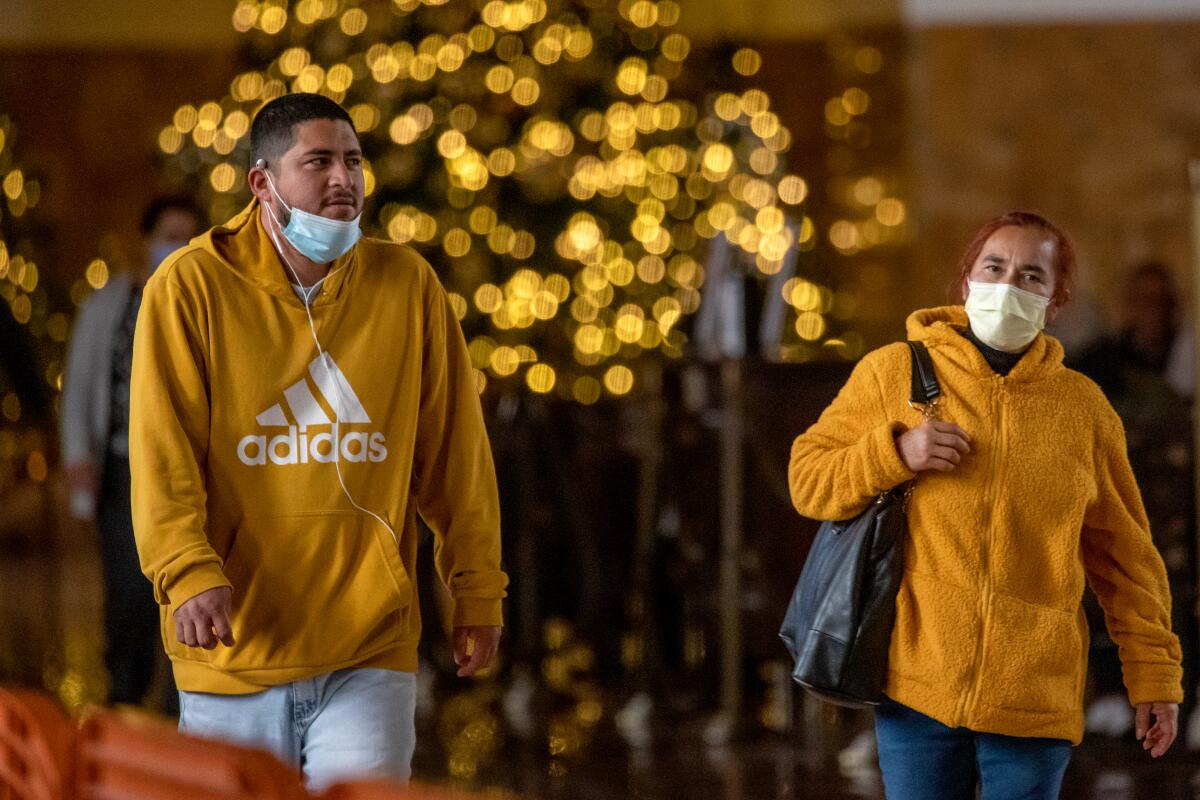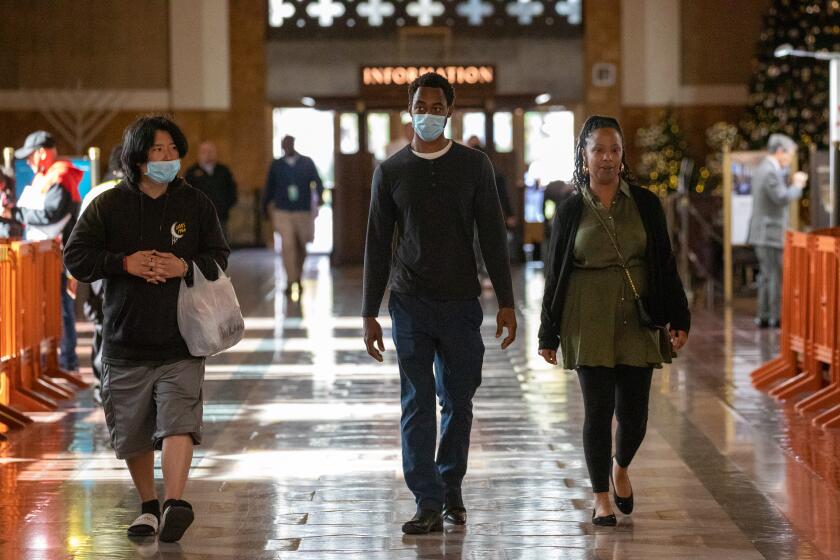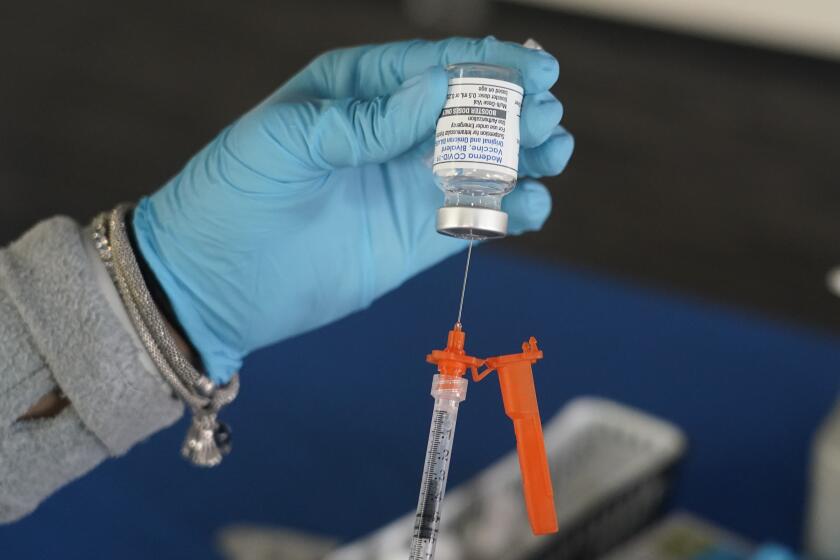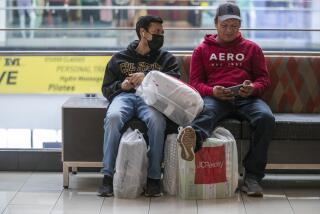L.A. County hits high COVID-19 community level, but mask mandate far from certain

- Share via
Los Angeles County has again entered the high COVID-19 community level, further indication that the continuing spike in cases is starting to exert pressure on the region’s hospitals.
Should hospitalization rates continue to rise this month, the county could be on track for a renewed universal mask order in indoor public settings.
But it’s uncertain when such a rule might be handed down — or whether one will materialize at all. County Public Health Director Barbara Ferrer expressed some optimism Thursday that such a measure may be avoided.
“I think it’s fair to say that I’m feeling more hopeful that our metrics might improve before they tank,” she said.
However, given recent increases in coronavirus transmission and hospital admission rates, Ferrer urged residents to voluntarily mask up in indoor public settings.
“We know everyone is super focused on when might this be a universal masking, indoor masking requirement, but what we really want to focus on today is: We all need to wear our mask now,” she said. “We haven’t reached that super dangerous threshold … but ... there’s just too much transmission and it’s creating a lot of risk. And the time to mitigate the risk is actually now.”
With coronavirus cases surging and hospitalizations worsening, Los Angeles County is again facing the possibility of a renewed public indoor mask mandate.
L.A. County has already met one of two criteria that would trigger a new mandate: a relatively high rate of new coronavirus-positive hospitalizations. The county is now reporting 14.8 new coronavirus-positive hospitalizations a week for every 100,000 residents; a rate of 10 or more is considered particularly worrisome.
The second focuses on the share of staffed hospital beds occupied by coronavirus-positive patients. According to the U.S. Centers for Disease Control and Prevention, 6.9% of L.A. County’s staffed hospital beds are being used by coronavirus-infected patients, up from 5.6% from the prior week. However, that figure would need to be 10% or greater for a mask mandate to be on the table.
Ferrer previously estimated that L.A. County might reach the second benchmark around Dec. 19. Since the county would need to exceed both metrics for two weeks, any new mandate wouldn’t have gone into effect until the first week of January, at the earliest.
But the latest data Ferrer shared Thursday showed the county’s hospitalization rate has started to level off this week. Should that trend continue, hitting the second hospitalization metric would be further off or less likely to happen at all.
The share of staffed hospital beds being used by coronavirus-positive patients climbed by 23% from the prior week. That’s a gentler increase than the prior week-over-week jump of 40%.
With coronavirus cases and hospitalizations rising in Los Angeles County, officials are voicing new confidence in the effectiveness of the updated COVID-19 booster shot.
Case rates are also not spiking at the same rate seen just a few days ago. L.A. County was recording 3,780 coronavirus cases a day, or 262 cases a week for every 100,000 residents, for the week that ended Thursday.
The latest figure is actually a bit lower than the rate for the weekly period that ended Wednesday. But it also represents a 40% week-over-week increase — concerning, though gentler than the 81% week-over-week increase seen over the weekend.
A rate of 100 cases a week for every 100,000 residents is considered high.
That’s not to say the danger has passed. Infection rates could accelerate again. And even if things stabilize, there’s already a risky amount of coronavirus circulating throughout L.A. County.
“With a higher number of cases, we see more transmission,” Ferrer said. “This means that your chance of catching COVID during your routine activities — grocery shopping, eating out, running errands, going to work — will increase.”
Given the county’s current case rate, Ferrer estimated there’s an 80% to 90% chance that at least one person at a gathering of 200 is infected.
“If you’re going to an event such as a concert or a large Christmas party, there’s now a higher likelihood that one or more persons at the event is infected. They could unknowingly infect you, and you, in turn, could unknowingly infect your friends, your co-workers or your family.”
The latest maps and charts on the spread of COVID-19 in Los Angeles County, including cases, deaths, closures and restrictions.
L.A. County hasn’t been in the high COVID-19 community level since summer, the last time when it appeared a mask mandate might be imminent. Placement in that category, which is defined by the CDC, requires a county to have an elevated level of coronavirus transmission and meet a certain hospitalization threshold.
The county’s move into the high COVID-19 community level Thursday was the result of its case rate exceeding 200 cases a week for every 100,000 residents.
Eight California counties entered the high COVID-19 community level Thursday: Los Angeles, San Bernardino, Santa Clara, Santa Cruz, Imperial, Kings, San Benito and Tuolumne. Nearly 15 million Californians live in those areas, accounting for 38% of the state’s population.
When a county’s community level is high, the CDC recommends residents “wear a high-quality mask or respirator,” and that those “at high risk of getting very sick consider avoiding non-essential indoor activities in public” where they could be exposed to the coronavirus.
Ferrer, though, emphasized that L.A. County is “not asking people to curtail their activities, to avoid activities or to shut down any activities.”
“We’re letting people know that the risk is higher with elevated transmission,” she said. “And because this is having an impact on our healthcare system and our vulnerable residents, it’s time to layer in sensible protections.”
Cases and hospitalizations are climbing rapidly, raising the possibility of a renewed public indoor mask mandate.
Seventeen counties entered the medium COVID-19 community level: San Diego, Riverside, Alameda, Contra Costa, Ventura, San Joaquin, Tulare, Solano, Napa, Sutter, Yuba, Lake, Calaveras, Lassen, Del Norte, Colusa and Inyo.
They joined 18 counties already in the medium level: Orange, Sacramento, Fresno, Stanislaus, Monterey, Placer, Merced, Yolo, Butte, El Dorado, Madera, Nevada, Mendocino, Tehama, Siskiyou, Glenn, Mariposa and Sierra.
There are 20 million Californians who live in the 35 counties in the medium level, accounting for 51% of the state’s population.
When a county’s COVID-19 community level is medium, the CDC recommends people at high risk of getting very sick to wear a mask or respirator in indoor public settings.
Two counties fell from the medium to low COVID-19 community levels: Sonoma and Marin counties. The other 13 counties in the state that remain in the low level are Kern, San Francisco, San Mateo, Santa Barbara, San Luis Obispo, Shasta, Humboldt, Amador, Plumas, Mono, Trinity, Modoc and Alpine.
More to Read
Sign up for Essential California
The most important California stories and recommendations in your inbox every morning.
You may occasionally receive promotional content from the Los Angeles Times.
















